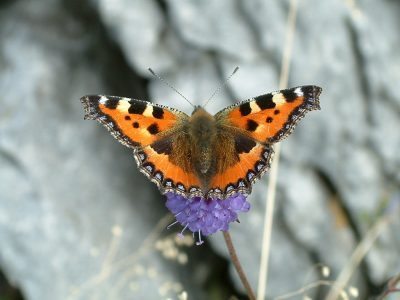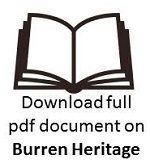Fauna
The unique habitats of the Burren – unfertilized, species-rich grasslands, scattered pockets of scrub and woodland, sheer cliff faces, extensive winter wetlands and ocean frontage – provide the ideal balance of habitats for the feeding and nesting activities of many species.
General Animals
Feral goats, foxes, and hares are the most common mammals encountered in the Burren uplands, with rabbits once common but now much less so. One of the most renowned members of the Burren’s faunal community is the pine marten – the ‘tree cat’ whose agile ways have a bad reputation for getting into the chicken coop. Woodmice are very common in hazel woodland and play an important role in harvesting hazel nuts. Red squirrels and pygmy shrews are also common in hazel woodland. Other mammals found in the Burren include the badger, stoat, bank vole, mink, and brown rat. Seven of Ireland’s native bat species are found in the Burren, with a very significant population of the Lesser Horseshoe Bat in the region.
Among the amphibians and reptiles, the common frog, smooth newt, and common lizard are also found in the Burren. Another interesting members of the Burren reptilian fauna is the slow worm, in reality a legless lizard, a specimen of which was described by McCarthy (1977) and thought be introduced about this same time. Other than that over seventy species of land snails have been recorded in the area, thanks in no small part to the abundance of shell-building calcium carbonate.
Moths and Butterflies
You won’t come to the Burren on a summer’s day without seeing an array of winged friends fluttering past. One moth species, the Burren Green has its only station in the British Isles here. The wonderful Burnet moths can also be found in great abundancy; while a rich and diverse array of butterfly species are found in the Burren, testament to the purity of this environment and the wide range of food plants available. All but two of Ireland’s 30-odd butterfly species are found in the Burren, with the Pearl Bordered Fritillary and the Brown Hairstreak being almost limited to the area. Below is a list of the butterflies present, their common name, Latin name and status of these species in the region.
Moths and Butterflies in the Burren
| English Name | Latin Name | Status |
|---|---|---|
| Wood White | Leptidea sinapis | Widespread |
| Brimstone | Gonepteryx rhamni | Widespread |
| Large White | Pieris brassicae | Widespread |
| Small White | Artogeia rapae | Widespread |
| Green Veined white | Artogeia napi | Widespread |
| Orange Tip | Anthocharis cardamines | Widespread |
| Green Hairstreak | Callophrys rubi | Scarce |
| Brown Hairstreak | Thecla betulae | Scarce |
| Small Copper | Lycaene phlaeas | Scarce |
| Small Blue | Cupido minimus | Scarce |
| Common Blue | Polyommatus icarus | Widespread |
| Holly Blue | Celastrina argiolus | Scarce |
| Pearl-bordered Fritillary | Clossiana euphrosyne | Scarce |
| Dark Green Fritillary | Argynnis ahlaja | Widespread |
| Silver-washed Fritillary | Argynnis paphia | Scarce |
| Marsh Fritillary | Euphdryas aurinia | Scarce |
| Speckled Wood | Pararge aegeria | Widespread |
| Wall Brown | Lasiommata megera | Widespread |
| Grayling | Hipparchia semele | Widespread |
| Gatekeeper | Pyronia tithonus | Very Scarce |
| Meadow Brown | Maniola jurtina | Widespread |
| Ringlet | Aphantopus hyperantus | Widespread |
| Small Heath | Coenonympha pamphilus | Widespread |
| Dingy Skipper | Erynnis tages | Widespread |
| Small Tortoiseshell | Aglais urticae | Widespread |
| Peacock | Inachis io | Widespread |
| Red Admiral | Vanessa alalanta | Migrant |
| Painted Lady | Vanessa cardui | Migrant |
Birds
The Burren, though not renowned for its bird life, happens to be one of the best places in Ireland to hear the cuckoo, testament to the deceptive wealth of the region’s bird life which includes seven species listed in Annex 1 of the European Birds Directive. In total, over 100 species of breeding birds were identified in a survey of the Burren and the Aran Islands, amounting to over 70% of the national total. These include skylarks, best known for their wonderful song, peregrine falcons, those birds of prey par excellence, wonderful soaring ravens with their throaty calls, and Brent Geese who travel across the Atlantic every year to visit our shores.
In pockets of scrub, the chaffinch, song thrush, wren, robin, dunnock, yellowhammer and blackbird are commonly found nesting. Meadow pipits and wheatears are characteristic breeders on limestone pavement-grassland-scrub mosaics, while turloughs attract considerable winter populations of widgeon, teal and shoveler ducks, as well as whooper swans, golden plovers, and lapwings. Among the spectacular birds of prey, the sparrowhawk, kestrel, peregrine falcon, hen harrier and merlin are found in the Burren.
10 Fantastic FACTS about the Burren’s Fauna
- The Burren is one of the best places in Ireland to hear the Cuckoo, testament to the deceptive wealth of the region’s bird life which includes seven species listed in Annex 1 of the European Birds Directive.
- In total, over 100 species of breeding birds were identified in a recent survey of the Burren and Aran islands, amounting to over 70% of the national total.
- The Burren is commonly considered to be the Irish stronghold of the once-threatened pine marten species due to the ample and extensive habitat provided by hazel scrub, a situation not welcomed by many farmers who consider the ‘marten cat’ a leading predator of young lambs.
- Woodmice are very common in hazel woodland and play an important role in harvesting hazel nuts.
- Seven of Ireland’s native bat species are found in the Burren, with a very significant population of the Lesser Horseshoe Bat in the region.
- One of the Burren’s most unusual and interesting faunal species is slow worm, a snake-like legless lizard.
- As well as the common lizard, another species, the green lizard has been spotted here, linked to a 1958 release of fifteen such lizards in the area.
- One moth species, the Burren Green, has its only station in the British Isles here.
- The yellow ant is widespread in the Burren. This thermophilous (warmth-loving) species favours shallow soils on limestone to build its nests, and has been used to identify ‘old-field’ grassland communities.
- One particularly striking, almost symbolic, aspect of the Burren’s fauna are the numerous herds of feral goats that roam freely across the uplands, estimated to number over one thousand individuals. Recent studies suggest that these herds are unique in Europe, in terms of both their extent and their population ecology.

